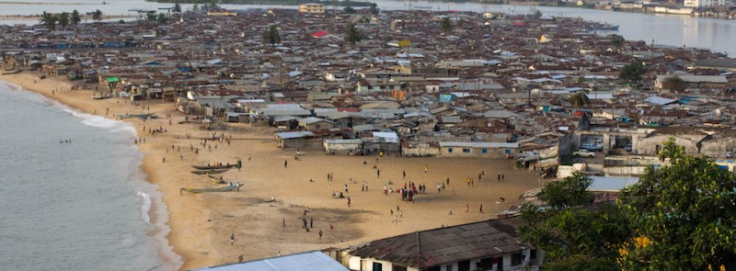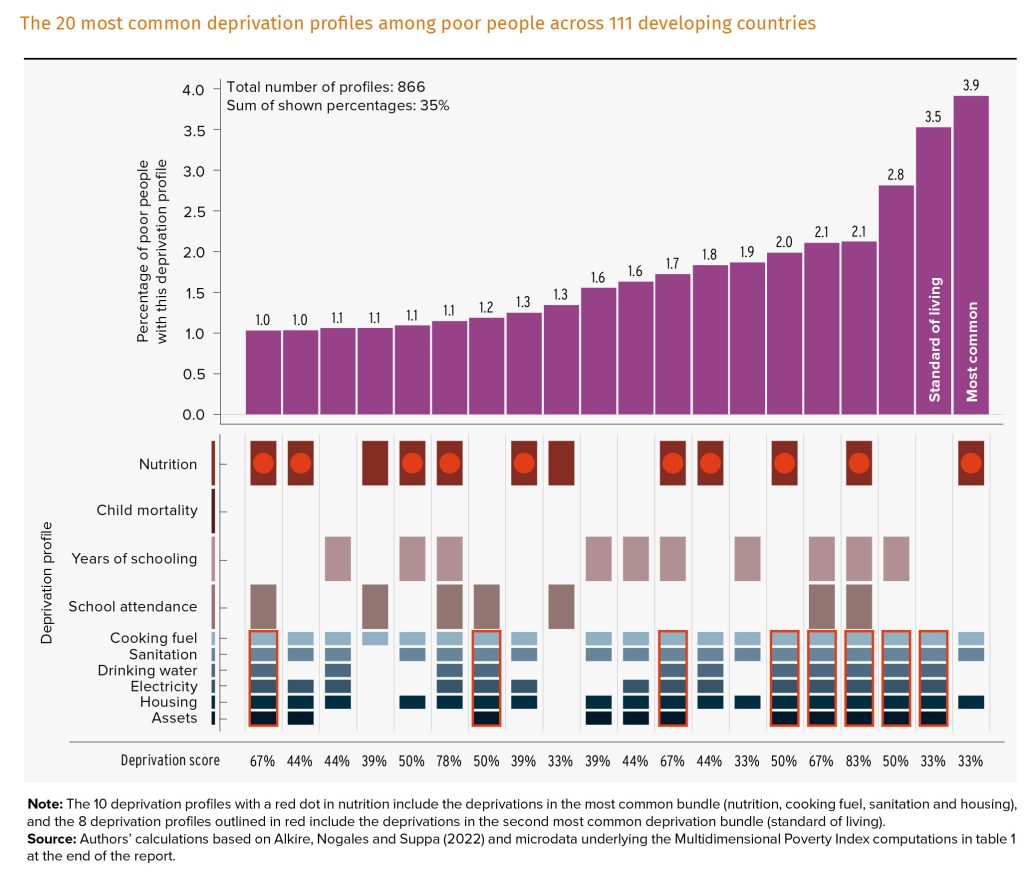
Search
Interlinked Hardships: MPI Deprivation Profiles

Since its initial publication in 2010, the global Multidimensional Poverty Index (MPI) has provided valuable insights into complex poverty conditions, examining their variations across countries, demographics, geographic locations, and regions.
Today, the MPI is widely recognized as a vital resource for international policymakers, aiding in the creation of targeted interventions to address the unique needs of individuals and families living in poverty.
However, meeting the high standards set for a policy tool of this nature requires the acknowledgment that addressing the hardships faced by those experiencing poverty necessitates multiple coordinated actions.
Additionally, it is crucial to recognize that individuals living in poverty are not uniform in their experiences. The experience of poverty varies between different groups, regions, countries, and even within different areas of the same country. For instance, a person living in a rural area may be considered multidimensionally poor due to a lack of access to education, proper sanitation, and clean cooking fuel, while someone in an urban area may face poverty as a result of inadequate nutrition, housing, and assets. In essence, poverty takes on different forms for different people.
The MPI enables the identification of specific deprivation profiles among the poor. This analysis surpasses traditional approaches that rely solely on decomposition and dimensional breakdown, as it recognizes that different profiles and experiences of poverty are shaped by the interconnections between various deprivations. Understanding these interlinkages aids in the development of integrated multisectoral policies that strategically address multiple deprivations simultaneously, alleviating the burden on impoverished individuals.
The 2022 global MPI report delves into the deprivation profiles of poor individuals in 111 developing countries. The most common profile affects 3.9% of the poor population, involving simultaneous deprivations in nutrition, cooking fuel, sanitation, and housing. This evidence suggests that over 45 million poor individuals could greatly benefit from a comprehensive policy programme that simultaneously addresses these deprivations, with most of them residing in South Asia.
The second most common deprivation profile encompasses simultaneous deprivations in six standards of living indicators, including cooking fuel, sanitation, drinking water, electricity, housing, and assets. Around 41 million people are poor due to this profile, and it is most prevalent in Sub-Saharan Africa, accounting for 5.9% of the poor population (34.2 million).
While identifying the most prevalent deprivation profiles has significant policy implications, another relevant approach involves focusing on predetermined pairs and triplets of deprivations experienced by the poor, allowing for a coordinated response. For instance, many programmes worldwide combine water, sanitation, and hygiene (WASH) initiatives.
Analyses presented in the global MPI report 2022 demonstrate that over 1 billion poor individuals are deprived of either sanitation or drinking water, and 437.1 million are deprived of both. The vast majority of those experiencing both deprivations reside in Sub-Saharan Africa (330.4 million), followed by South Asia (47.5 million).
Even countries with nearly identical MPI values can exhibit different deprivation profiles, underscoring the importance of analyzing deprivation interlinkages.
A similar analysis reveals that approximately 470 million poor individuals are deprived of both nutrition and sanitation, potentially making them more susceptible to infectious diseases.
Furthermore, over 593 million poor people lack both cooking fuel and electricity, highlighting the potential impact of clean energy interventions in poverty alleviation.
Similarly, more than 259 million poor individuals are deprived of both nutrition and school attendance, emphasizing the integrated response of school feeding programmes to address nutritional deprivations and incentivize school attendance among children.
It is worth emphasizing that even countries with nearly identical MPI values can exhibit different deprivation profiles, underscoring the importance of analyzing deprivation interlinkages. For example, in 2019, Liberia and Senegal had similar MPI values (0.259 and 0.263, respectively), but the percentage of poor individuals deprived of both sanitation and drinking water was 39.0% in Liberia and 21.9% in Senegal.
This information is vital for designing country-specific water and sanitation joint programmes, as these initiatives require distinct configurations and reach, even in countries with similar overall levels of multidimensional poverty.
To further emphasize the significance of deprivation interlinkages in effective policymaking, the global MPI report presents three case studies: Ethiopia, Lao People’s Democratic Republic, and Nepal.
In Ethiopia, for instance, significant poverty reduction has been achieved through various strategies, including GDP growth, infrastructure investment, and agricultural development. Notable initiatives like the Productive Safety Net Programme (PSNP) have provided support to millions of impoverished individuals, addressing multiple deprivations.
However, recent challenges such as the Covid-19 pandemic and conflicts have posed obstacles to sustaining poverty reduction efforts. In the context of Ethiopia, understanding that the most common deprivation profile in 2019 was the standard of living profile (deprivation in all six standard of living indicators: cooking fuel, sanitation, drinking water, electricity, housing, and assets) is crucial.
The second most common profile is the standard of living profile combined with deprivations in years of schooling. Approximately one in five poor individuals in Ethiopia experience one of these two profiles. Moving forward, the country could benefit from including a housing package in pro-poor programmes, focusing on energy, water, sanitation facilities, and home improvements.
Thus, the 2022 global MPI report presents the first comprehensive analysis of in-depth deprivation profiles derived from data on millions of households across 111 countries.
This analysis complements more traditional approaches to multidimensional poverty, showcasing that impactful policies against poverty must transcend institutional silos and address interconnected dimensions of poverty together. While this is an ambitious task for policymakers, it is also an achievable one.
Out of the 81 countries with trend data analyzed in the report, 72 significantly reduced their MPI values during at least one of the study’s time periods. Among these 72 countries, 68 achieved significant reductions in deprivations across five or more indicators, with 46 countries reducing deprivations in eight or more indicators.
Moreover, 63 countries reduced deprivations among rural poor individuals in five or more indicators, while 22 countries reduced deprivations across all 10 MPI indicators.
These findings demonstrate that reducing multiple deprivations is possible, even for the most impoverished populations. The key to reinforcing these reductions lies in carefully designed multisectoral policies and evidence-based interventions that target interlinkages.

Source: 2022 Global MPI report.
This article was published in Dimensions 15
















